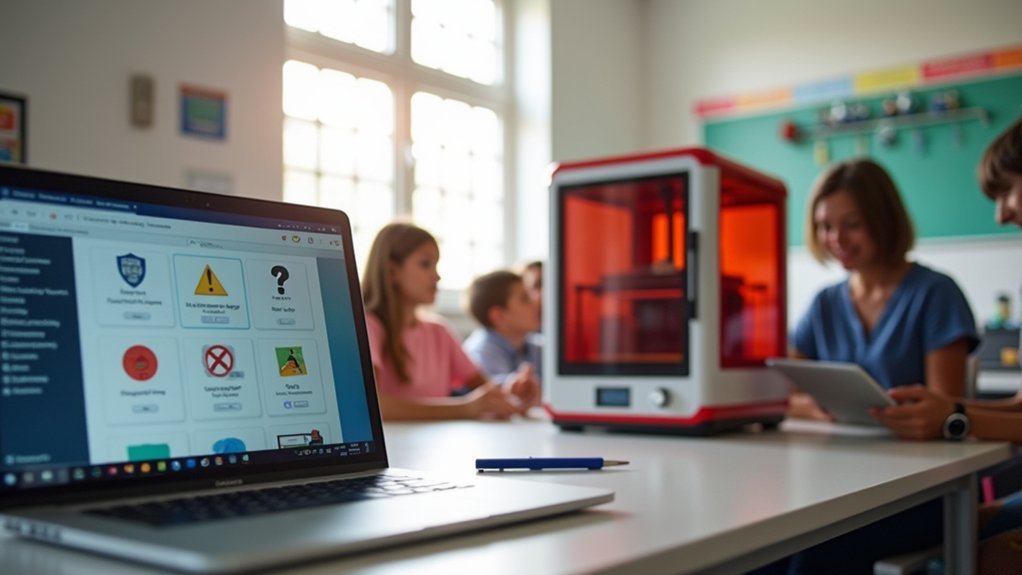When choosing 3D printing software for schools, you’ll need to match interface complexity with your students’ developmental stages—elementary kids require drag-and-drop functionality while high schoolers can handle advanced tools like Fusion 360. Prioritize platforms offering free educational licenses, broad printer compatibility, and robust safety features with user access controls. Cloud-based solutions provide better scalability and collaboration tools than desktop options, while effective print management can increase utilization by 357%. Continue exploring these considerations to build a program that truly enhances STEM learning.
Understanding Your Educational Goals and Student Needs

Before diving into software features and technical specifications, you must first establish clear educational goals that will guide your 3D printing program’s direction.
Consider what you want students to achieve through printing education – whether it’s developing spatial reasoning, enhancing creativity, or preparing them for STEM careers.
Your educational goals should align with curriculum standards and grade-appropriate learning outcomes.
Successful 3D printing programs require educational objectives that match both academic standards and students’ developmental readiness levels.
Elementary students need intuitive, drag-and-drop interfaces like TinkerCAD, while high schoolers can handle sophisticated tools like Fusion 360 for engineering projects.
Assess your student needs by evaluating their current technical skills, attention spans, and learning styles.
Consider how 3D printing software will support hands-on learning experiences and real-world problem-solving.
This foundation guarantees you’ll select tools that truly enhance student engagement and academic success.
Evaluating User-Friendly Interfaces for Different Age Groups
When you’re selecting 3D printing software for your school, you’ll need to match interface complexity with your students’ developmental stages and technical abilities.
Elementary students require drag-and-drop functionality and visual cues, while high schoolers can handle more sophisticated tools with advanced menus and professional-grade features.
You should prioritize software that offers clear navigation paths and age-appropriate design elements that won’t overwhelm younger users or bore older ones.
Age-Appropriate Design Features
The interface design of 3D printing software can make or break a student’s first experience with digital modeling. When selecting 3D printing software for schools, you’ll need to take into account age-appropriate design features that match your students’ developmental stages.
For elementary and middle school students (Grades 4–8), prioritize platforms like TinkerCAD that offer drag-and-drop functionality, emphasizing creativity and basic design principles without overwhelming complexity.
High schoolers (Grades 9–12) can handle more sophisticated tools like Fusion 360’s parametric design features. User-friendly design greatly reduces learning time, allowing students to focus on actual modeling projects.
Look for software with built-in tutorials, accessible project ideas, and streamlined file management systems that simplify print job submission for younger users.
Intuitive Navigation Standards
Since students’ attention spans vary dramatically across grade levels, evaluating navigation standards becomes essential for selecting effective 3D printing software. You’ll need printing software for schools that accommodates different developmental stages and technical abilities.
User-friendly design should enable students to complete tasks efficiently. When students can submit print jobs in under 30 seconds, you’ll maintain classroom engagement and momentum.
Intuitive navigation must scale appropriately—younger students benefit from drag-and-drop interfaces like TinkerCAD, while high school students can handle more sophisticated tools like Fusion 360.
Consider these navigation elements:
- Clear visual icons that communicate functions instantly
- Streamlined workflows reducing clicks between common tasks
- Age-appropriate terminology matching students’ vocabulary levels
- Thorough educational resources supporting independent exploration
Effective navigation standards guarantee all students succeed regardless of their technical background.
Budget Considerations and Cost-Effective Solutions

Budget constraints shouldn’t force you to compromise on quality when selecting 3D printing software for your school. Smart budget considerations focus on long-term value rather than just upfront costs.
While low-cost printers might seem appealing, they often create higher maintenance expenses that’ll strain your resources.
Cost-effective solutions include leveraging free educational licenses for robust 3D printing software like TinkerCAD and Fusion 360. These platforms provide professional-grade tools without licensing fees.
Cloud-based systems reduce administrative costs by automating data tracking and minimizing manual oversight requirements.
Effective software management can increase your 3D printer utilization by 357%, maximizing your investment’s return.
Extensive packages that streamline filament usage tracking and print job management often deliver better district-wide value than piecemeal solutions.
Compatibility With Existing Hardware and Printers
You’ll need software that supports multiple printer brands and models to maximize your existing hardware investments.
Your chosen platform should integrate seamlessly with current printers without requiring extensive technical modifications or complicated setup procedures.
Focus on solutions that offer broad compatibility across different manufacturers while providing the flexibility to manage various printer types from a single interface.
Multi-Printer Support Systems
Multi-printer support systems represent a game-changing solution for schools managing diverse 3D printing fleets, offering compatibility with over 180 different printer models.
These systems transform how educational institutions handle their 3D printing workflows by consolidating printer management into a single, streamlined interface.
Your school can leverage 3D printing management software to standardize processes across departments and locations.
Browser-based controls enable remote printing supervision, allowing teachers to monitor jobs from anywhere on campus.
Advanced model preparation tools guarantee files work seamlessly with various printer types, boosting success rates.
Key benefits include:
- Unified control panel displaying all printers in real-time status
- Cross-platform compatibility supporting existing hardware investments
- Streamlined workflow management reducing technical complexity for educators
- Enhanced resource efficiency through centralized monitoring and scheduling
Hardware Integration Requirements
Schools investing in 3D printing software must prioritize compatibility with their existing hardware ecosystem to maximize educational value and minimize additional costs.
You’ll need software supporting over 180 printer types to guarantee extensive compatibility with your current equipment. Look for solutions that integrate seamlessly with existing slicer software like Ultimaker Cura, eliminating the need to retrain staff on new preparation tools.
Choose printing management software that connects with cloud-based platforms for efficient oversight across multiple devices.
Your selected solution should enable remote job management while working with your current printer hardware. Verify that the software includes advanced model preparation and visualization tools compatible with various printer models.
Effective 3D Printer Management Cloud capabilities will streamline operations and reduce technical barriers for educators and students.
Safety Features and Classroom Management Tools

When managing 3D printers in educational environments, robust safety features and classroom management tools become essential components that can make or break your program’s success.
You’ll need software that offers thorough monitoring print jobs capabilities to detect failures before they cause accidents or damage expensive equipment. Look for platforms with user access controls that let you manage student permissions and prevent unauthorized printing sessions.
Effective classroom management requires visibility into every aspect of your printing operations. Cloud-based solutions enable remote monitoring, so you can check on jobs from anywhere in the building.
- Students gathering around a printer display showing real-time temperature readings and layer progress
- Teachers reviewing detailed print logs displaying timestamps, filament usage, and completion rates
- Automated alerts appearing on smartphones when print failures occur
- Budget dashboards tracking monthly filament costs per student project
Training Resources and Educational Support Materials
You’ll need robust training resources and educational support materials to successfully implement 3D printing software in your classroom.
Effective teacher training programs guarantee you’re confident using the technology and can troubleshoot common issues that arise during lessons.
Student learning materials and curriculum integration guides help you seamlessly incorporate 3D printing into existing subjects while maintaining educational objectives.
Teacher Training Programs
Although 3D printing software offers tremendous educational potential, its success depends heavily on how well teachers can implement and guide students through the technology.
Teacher training programs focus on hands-on workshops that provide practical applications of industry-standard software like TinkerCAD and Fusion 360. These thorough programs guarantee educators develop confidence in 3D printing technologies before introducing them in educational settings.
Effective teacher training programs typically include:
- Interactive workshops where educators design and print their own models
- Step-by-step tutorials covering software navigation and troubleshooting techniques
- Curriculum integration strategies that align with existing lesson plans
- Ongoing support through educator communities with 300,000+ active users
You’ll find that well-trained teachers can seamlessly guide students through complex design processes while maintaining classroom engagement and learning objectives.
Student Learning Materials
Thorough student learning materials form the foundation of successful 3D printing education, transforming complex design concepts into accessible, engaging activities.
You’ll find pre-designed student activities that seamlessly align with your curriculum requirements, eliminating time-consuming lesson preparation while maintaining educational quality.
Educational licenses for professional software like TinkerCAD and Fusion 360 provide students access to industry-standard tools without budget constraints.
These platforms enable hands-on 3D modeling experiences that develop critical thinking and design skills.
Comprehensive tutorials and project ideas support your teaching methodology, while digital reflection sheets help students document their learning journey.
Post-assessment tests measure understanding and reinforce key concepts.
You’ll have everything needed to implement effective 3D printing education, from beginner-friendly activities to advanced modeling challenges that prepare students for future STEM careers.
Curriculum Integration Guides
Successful 3D printing implementation depends on structured curriculum integration guides that bridge the gap between technology and educational objectives.
You’ll need extensive resources that align 3D printing software with your specific curriculum standards and learning goals. These guides help you seamlessly incorporate technology into existing lesson plans while maintaining educational focus.
Effective curriculum integration guides provide you with:
- Step-by-step project workflows that connect 3D printing activities to specific learning outcomes across Science, Math, and Art subjects
- Ready-to-use lesson plans featuring classroom-tested projects that engage students in hands-on learning experiences
- Assessment rubrics and evaluation criteria designed specifically for 3D printing education projects
- Cross-curricular connections showing how single projects can address multiple subject areas simultaneously
These structured approaches guarantee your 3D printing software investment delivers measurable educational value.
Curriculum Integration and Standards Alignment
When you’re selecting 3D printing software for your school, ensuring it aligns with educational standards becomes essential for meeting curriculum requirements across STEM, STEAM, and other subject areas.
You’ll want software that supports interdisciplinary learning, allowing students to create projects spanning science, art, math, and language arts for thorough educational experiences.
TinkerCAD excels for K-8 students, offering hands-on tutorials specifically designed around educational standards.
For advanced learners, Fusion 360 provides industry-relevant certifications that align with higher education goals.
When you choose curriculum-aligned software, you’ll effectively measure student outcomes and skill development, making it easier to assess learning progress according to state and national standards while fostering meaningful cross-curricular connections.
Cloud-Based Vs Desktop Software Options
As schools increasingly adopt 3D printing technology, you’ll need to decide between cloud-based and desktop software solutions, each offering distinct advantages for educational environments.
Cloud-based solutions excel in educational settings by providing remote access capabilities, allowing you to submit print jobs from any internet-connected device. They streamline setup processes, eliminating complex installations across multiple school computers. Additionally, these platforms offer centralized 3D printing management for tracking usage and monitoring progress.
Cloud-based 3D printing solutions transform educational environments by enabling seamless remote access and eliminating complex installation barriers across multiple devices.
Desktop software typically requires individual installations, creating update challenges and compatibility issues. While it may offer advanced features, the steep learning curve makes it less suitable for K-12 contexts.
- Students accessing print queues from classroom tablets
- Teachers monitoring multiple printers from the staff room
- Administrators tracking filament costs across departments
- IT staff managing updates without visiting individual computers
Print Management and Administrative Controls
Beyond selecting the right platform, you’ll need robust print management and administrative controls to maintain order in your school’s 3D printing environment. Effective software for Higher Education provides complete visibility into print jobs, displaying user details and timestamps for better tracking.
You can pause or cancel problematic jobs while receiving alerts for print failures, preventing wasted materials and time. Advanced print management systems enable usage-based billing, allowing you to charge students for filament consumption and promote accountability.
These administrative controls facilitate seamless coordination between educators, students, and printers, optimizing resource allocation across your institution. Comprehensive reporting capabilities monitor all printing activities automatically, freeing you from manual oversight tasks.
This streamlined approach lets educators focus on teaching while maintaining efficient 3D printing programs.
Student Collaboration and Project Sharing Features
How can you transform individual 3D printing projects into dynamic collaborative learning experiences? By selecting software that prioritizes student collaboration and project sharing capabilities.
Look for platforms that enable seamless teamwork through real-time editing, allowing multiple students to work simultaneously on designs from any location. Cloud-based systems guarantee projects remain accessible across devices, eliminating workstation limitations that hinder group productivity.
Effective collaborative features should include:
- Live design sessions where students can simultaneously modify 3D models while discussing changes through integrated chat tools
- Version control dashboards that track each contributor’s modifications and allow teams to revert to previous iterations
- Peer review workflows enabling structured feedback cycles with comment threads attached to specific design elements
- Digital showcases featuring community galleries where classes can display finished projects and inspire future creations
Scalability for Growing 3D Printing Programs
When your school’s 3D printing program gains momentum, you’ll need software that grows alongside your expanding ambitions. Scalability becomes vital as you manage more users, 3D printers, and projects without sacrificing performance.
A cloud-based platform offers the flexibility to accommodate this growth seamlessly, letting you integrate new printers and handle increased workloads from one centralized interface.
Look for management software that supports diverse printer types—ideally over 180 models—so you can adapt to changing needs and budgets.
Versatile management software supporting 180+ printer models ensures your program adapts to evolving technological needs and budget constraints.
Standardization across disciplines guarantees consistent access to tools and resources as your program expands. Effective tracking capabilities for print jobs and filament usage become essential at scale, reducing administrative overhead while maximizing educational opportunities for your growing student population.
Frequently Asked Questions
What Is the Best Type of 3D Printing for Education?
You’ll want user-friendly software like TinkerCAD for younger students, enclosed printers for safety, cloud-based platforms for easy management, cost-effective solutions, and curriculum-aligned tools that enhance hands-on learning experiences.
What Is the Best 3D Printer for Schools?
You’ll want the XYZprinting da Vinci Jr. for elementary students due to its safety features, while the Ultimaker 2+ works best for high school with advanced capabilities and engineering applications.
What Is the 45 Degree Rule for 3D Printing?
You’ll follow the 45-degree rule to avoid support structures when 3D printing. Any overhang steeper than 45 degrees typically requires supports, so you should design features within this angle for better print quality.
How Can 3D Printing Be Used at Schools?
You can use 3D printing to create hands-on learning experiences across subjects, promote creativity through custom designs, support collaborative projects, and prepare students for future careers in STEAM fields.





Leave a Reply